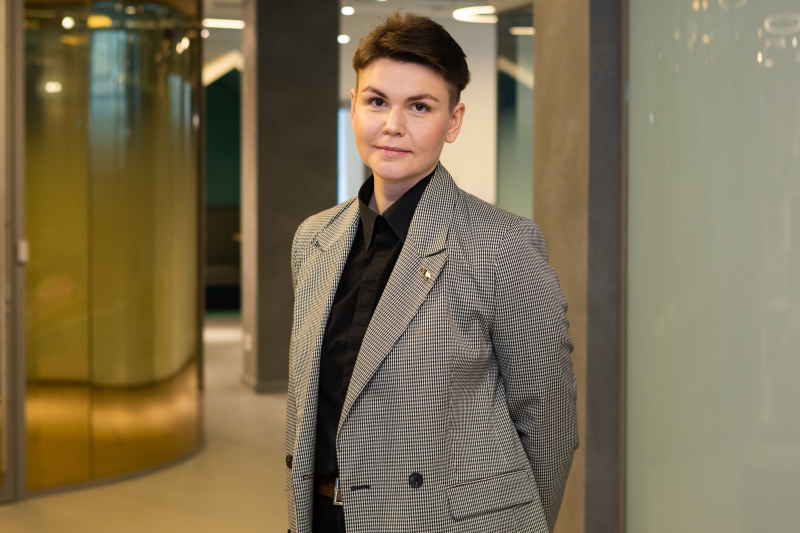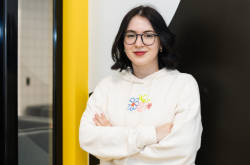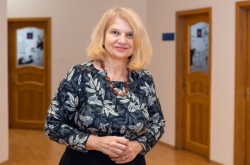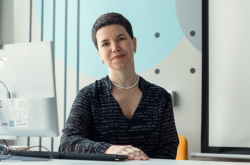You graduated from St. Petersburg State University having majored in biodiversity and environmental protection; then, you got your Master’s at ITMO with a major in systems and technologies for environmental protection. What draws you to the subject of ecology?
It all started when I was a kid. When I was about 11 years old, I decided I’d like to become an ecologist. I didn’t fully understand yet what that entailed, but I always liked nature. As fate would have it, I was able to go on an expedition to the Kandalaksha Nature Reserve with my biology teacher. That’s how my research career started. And after winning an entrance competition, I was able to enroll at St. Petersburg State University. Back then I thought I’d move to a nature reserve to do research, but the big city decided otherwise. I changed my mind about moving, but the love of expeditions remained. I go on field trips with children and adults alike in the capacity of an entomologist.
But at some point I started to grow disappointed in others’ attitude towards my field of science. It seems that a lot of fellow ecologists face this issue. A lot of the suggestions we put forth are met with doubt. Naturally, I started to lose heart. When I went on exchange to Utrecht University in the Netherlands to study the physics of climate, it felt like such a cool field of science that needed to be developed in Russia, but there was no demand for it here and at one point I was ready to give up on it all.
But ITMO kept me from doing that when I became part of a great team. These people are a joy to work and grow with.
You’re in the process of writing your PhD thesis. What is it going to be about?
In 2013, I enrolled in a PhD program on geoecology, studied for four years and passed my exams, but never finished my thesis. I really hope that I’ll defend it this year, but I don’t know if I’ll have the strength and time for it – it’s a task that requires concentration.
I study the biogeochemical cycle of carbon and its modern modifications; I study the human contribution to that process and use that data to model the cycle. Since this chemical element is present in so many parts of our environment – in the ground, in the atmosphere, and even within humans – its cycle is as follows: we excavate things and burn them, the emissions go into the atmosphere, and humans die, decompose, and return into the earth. It’s important to understand the carbon cycle because it affects climate change, and we in turn are affected by climate change both physically and economically.
If we don’t pay any attention to the fundamental issues, we won’t be able to make any administrative decisions. I always joke that ecologists are actually quite selfish: we save others not out of kindness, but because we want to take care of ourselves.

Irina Timofeeva. Photo by Dmitry Grigoryev, ITMO.NEWS
How did you start teaching at ITMO?
I started out as a teaching assistant when I was getting my Master’s in 2011; nowadays, that’s called ITMO.Mentors. Over time, I collected material, experience, and approaches that I wanted to apply. So when I started my PhD studies, I decided to become a teacher. First, I oversaw practical classes as a researcher, then I was offered a spot as a lecturer.
Today, I teach the courses Sustainable Development and Ecological Management as well as Conscious Consumption. I’ve also developed a special physics-focused ecology course for the School of Physics and Engineering and I teach the course Fundamentals of Natural Science at the Faculty of Technological Management and Innovations – as well as a course on climate monitoring for Master’s students where we discuss the physical foundations of climatology and the ways of studying climate.
What is an integral part of teaching for you?
That would probably be constant self-education and exchange of knowledge with students. Students today have unusual interests. One time, my students asked me what living organisms would look like on other planets in certain conditions. I told them about extremophiles, which exist on our own planet, and posited how they’d be different if they lived at higher temperatures or breathed a different atmosphere based on the data we already have. Students also have a lot of questions about the power industry, its advantages and drawbacks, because even scientific articles today contain a lot of contradicting information. That’s why it’s important to teach your students not to memorize facts, but to think critically and base their opinion on their own knowledge and experience.
In some fields, students might even know more than the teacher, so there’s a process of parallel development and mutual learning. It’s important to keep your eye on the latest research, especially since ecology is one of the most rapidly developing scientific fields and there are new studies coming out all the time.

ITMO.EduStars 2021 winners. Photo by Dmitry Grigoryev, ITMO.NEWS
When you participated in ITMO.EduStars, your performance was evaluated not only by experts but also by students. What do you think your students enjoy most in your teaching style?
It’s hard to be objective here but I think that my students love that our classes are lively, interactive, and also practice-oriented since nowadays, everyone strives for practical outcomes. That’s what I like about doing projects: once they’re completed, you can submit your work to various competitions. Last semester, during our classes on sustainable development, my Master’s students and I were working on a project that later advanced to the national stage of a contest with a prize of 5,000 euros. If our project wins, my students will receive 30,000 euros. And that’s a nice bonus!
I also stand by the idea of self-study. I let my students study some topics at home and then we have a group discussion. I also offer them a list of recommended popular science books and movies on ecology and sustainable development so that they could learn more about these topics on their own. There are many ways to make learning fun and efficient and also help students find their career paths. We as teachers should guide them and educate them on all available opportunities.
You’re involved in several ecological projects, among which are a podcast named Science Bar Hopping and an online course on modern energy technologies. What other projects are you currently working on?
I’m also on the jury for school environmental competitions and review school projects. I was once a regular at various contests, too, so I genuinely enjoy what I’m doing. If I can, I always try to take part in expeditions organized by the Komarov Botanical Institute and join the Zhivaya Voda (Living Water – Ed.) expedition as an entomologist every summer. Of course, when it’s not on the days of admissions, since I work there, too. My colleagues and I occasionally get invited by Science Bar Hopping and the Bumaga online newspaper to talk about science, and I’m always happy to give lectures outside ITMO.
For the past five years, my illustrator and I have been preparing a children’s book that will describe some of the animals that have gone extinct because of humans. Although there are already similar books worldwide, ours will be a bit different. While existing books talk about already well-known animals, we’ve made an effort to create a complete overview of extinct organisms from the Age of Exploration until now using the data provided by the International Union for Conservation of Nature and Natural Resources. Our book has over 80 spreads and can be compared to a graphic novel. To avoid a mere listing, we also added some fun facts about culture, history, and other fields. This way, we will be able to show how cool those animals were and how their extinctions affected humanity.
A Science Bar Hopping episode with Irina Timofeeva
Is it possible to bring extinct animals back?
We could, but should we? The thing is, the existing museum specimens show low genetic diversity. There are technologies and restoration projects to bring back the passenger pigeon, for instance. However, they need more funding. Besides, if we did manage to restore the species, then we would need not only the genotype and phenotype but also other members of the species to teach it just like other birds, and its reintroduction can have unknown future effects. That’s why I believe that we should preserve what we have instead of bringing back the lost.
Several years ago, you gave a science slam about the “sixth extinction” at Science Slam Ecology, and your speech won the audience vote. What is it and what does it mean for humankind?
Our planet has lived through five mass extinctions. We know best about dinosaurs because they’re fairly common in series and movies. Before the last dinosaur died, there were several other species that disappeared for good. Their extinctions brought about new evolutionary processes: when dinosaurs died out, mammals were able to expand. It means that all extinctions – except for dinosaurs that were also killed by an asteroid – were caused by long-lasting climate changes. Today, some reputable scientific journals report that the current extinction rates of species far exceed that of the five previous mass extinctions. We should start thinking more about what kind of world we want to create since no matter how hard we try to separate ourselves from nature, we’re still part of it. No telling what kind of danger, after the pandemic, humans might encounter.
You’ve also recently delivered a talk about modern global environmental, economic, and social challenges and the possible ways to overcome them using natural technologies. How can nature help us with environmental problems?
Recent years saw an intense development of NBIC convergence (nanotechnology, biotechnology, information technology, and cognitive science), which is associated with the sixth technological paradigm. Biomimetics is gaining traction, too. People now have more and more tools to study nature. In fact, evolution is the finest creator as it’s already created everything we need. For far too long, some natural phenomena had no scientific explanations. For instance, we had no idea about how geckos manage to climb up a smooth glass without falling off. As it turned out, their feet are covered in tiny hairs, which in conjunction with van der Waals forces allows them to adhere to many substrates. Some other solutions can be created with the help of the advances of AI and high-resolution microscopy.
Yet it’s important not only to study, for instance, how natural nanophotonic crystals in butterfly wings help them keep warm for a long time but also to take into account the full cycle when creating technology based on these studies. So that when these technologies are no longer of use or these devices break down, we can dispose of them without damaging the environment.
What do you enjoy doing in your spare time?
I like spending my free time with my family. I have a husband and a kid. We also have a cat and a dog. My current passion is my Instagram page. It now has over 3,000 followers. There, I share scientific news about extinct and endangered animals. I’m also fond of traveling, going on expeditions, and camping with both my family and my colleagues. Last summer, for example, we went to Lumivaara. I’m a big fan of nature. It boosts my energy and motivates me. Other than that, I’m keen on music and reading. My husband and I have a record collection, and I have all kinds of popular science books on physics, ecology, and biology.






